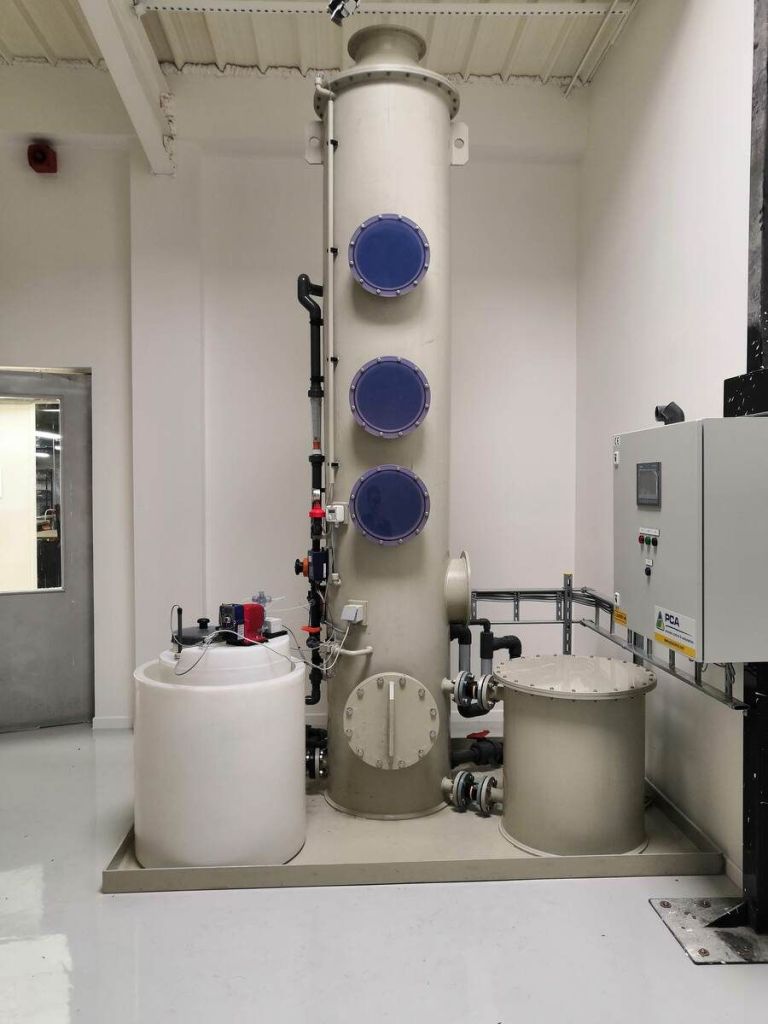In the context of rapid industrialization, the amount of emissions containing dust, chemical vapors, and toxic gases is increasing, placing heavy pressure on the environment. To control this situation, many modern treatment technologies have been researched and applied, among which the Scrubber exhaust gas treatment tower is a prominent solution. With its ability to effectively remove both dust and toxic gases, the Scrubber not only complies with environmental standards but also contributes to building a sustainable image for businesses.
The Scrubber exhaust gas treatment tower is a specialized device designed to remove gaseous pollutants or dust from industrial exhaust streams before being released into the environment. This is one of the most common exhaust gas treatment technologies, particularly effective for harmful gases such as SO₂, HCl, HF, NH₃, VOCs, and fine dust generated during production. With diverse applications, Scrubbers are widely used in industries such as cement, metallurgy, chemicals, pharmaceuticals, power generation, and food processing.
A standout feature of the Scrubber tower is its flexible operation with multiple configurations such as wet scrubbers, dry scrubbers, or semi-dry scrubbers. Among them, the wet Scrubber is the most widely used because it can simultaneously remove both dust and gaseous pollutants through direct contact between exhaust gas and the absorption solution. In addition, the equipment can be combined with other treatment methods to enhance efficiency and meet increasingly stringent emission standards for environmental protection.

What is a Scrubber Exhaust Gas Treatment Tower?
The operating principle of the Scrubber tower is based on the contact between exhaust gas and the absorption solution or filtering material to remove dust, toxic gases, or chemical vapors. When the exhaust gas enters the tower, it is directed through contact zones such as packing layers or spray systems, where the absorption solution is dispersed into fine droplets, increasing the contact surface with the gas stream. Pollutants are then dissolved, neutralized, or retained, ensuring the gas released meets standards before being discharged.
Specifically, this principle usually includes the following steps:
Thanks to this mechanism, Scrubbers can simultaneously handle multiple pollutants (dust + toxic gases), achieving high efficiency of 90–99% depending on the design and absorption solution used.
The solution tank stores water or absorbing chemicals (such as NaOH, Ca(OH)₂, H₂SO₄…) used for exhaust gas treatment. It is a critical component that determines the effectiveness of neutralization and absorption of harmful gases. The solution is continuously circulated to maintain stable concentration and avoid waste.
The circulation pump delivers the solution from the tank to the spray systems inside the tower. This ensures the solution is constantly recycled, reducing operating costs. It also maintains stable pressure, allowing the solution to be sprayed as fine mist for better contact efficiency.
The swirl plate inside the tower creates a vortex in the gas stream, causing larger dust particles to be separated by inertia and fall to the bottom. This enhances dust removal efficiency before the gas comes into contact with the absorption solution. It helps reduce the load on the subsequent treatment stages.
The spray system and nozzles are responsible for dispersing the absorption solution into fine mist, evenly covering the treatment chamber. This maximizes gas–liquid contact, improving pollutant absorption and neutralization. The nozzle design also determines solution-saving capacity and system durability.
The packing layer, usually made of plastic, ceramic, or stainless steel, provides a large wetted surface area. As the gas passes through the moistened packing, the contact area between gas and solution increases significantly, enhancing absorption efficiency of toxic gases. This is an indispensable part of packed towers.
The filter, also called a demister, removes any solution droplets carried along with the treated gas. Thanks to this, the outlet gas is cleaner, drier, and minimizes solution loss. This not only saves chemical usage but also prevents secondary environmental pollution.
The Scrubber tower is a flexible exhaust gas treatment technology, widely applied and highly effective in controlling industrial air pollution. Through the principle of gas–liquid or gas–absorbent material contact, this equipment can handle various pollutants with reliable efficiency. Despite some limitations in cost and maintenance, the Scrubber remains an optimal choice for many industries. In today’s green development trend, investing in and improving Scrubber technology is an important step toward cleaner production and sustainable growth.
.jpg)
Details of Modern Scrubber Tower Structure
If your business is struggling with controlling dust, toxic gases, or chemical odors from production activities, Đại Nam offers a comprehensive solution for consulting – design – installation of exhaust gas treatment systems using modern Scrubber technology. Our team of experienced engineers will conduct on-site surveys and provide tailored solutions for each industry, ensuring standardized treatment efficiency, cost savings, and long-term stable operation.